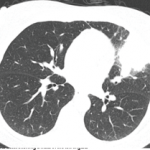Treatments for chronic enteropathies, such as IBD, including 5-aminosalicylic acid (5-ASA), corticosteroids, azathioprine and anti-tumor necrosis factor-α antibody (anti-TNF-α), are often ineffective in CEAS. However, we found one report of improvement with azathioprine.18 A case report of a male patient with CEAS and PDP indicates he was eventually treated with 5-ASA.19
Conclusion
A diagnosis of PDP is often delayed due to different presentations, such as pachyderma, arthritis, enlarged distal extremities and even GI ulceration. CEAS should be considered in those with chronic enteropathy and SLCO2A1 gene mutation, and the therapy may differ from that for IBD. Patients may not respond well to treatment and different options may need to be explored, with minimal consensus on the available options, other than NSAIDs and, potentially, pamidronate.
The patient in our case report met the diagnostic criteria for PDP given the arthralgias, skin thickening and periosteal reaction, even though he did not have some of the other features, such as clubbing or cutis verticis gyrata, at the time of diagnosis. Genetic testing confirmed the diagnosis, with abnormalities in the SLCO2A1 gene, which also made CEAS a concern given his GI symptoms, especially findings related to the ileum. The patient has shown some response to methotrexate and anti-TNF-α medications. Since the implementation of this regimen, plus the addition of physical therapy and a Crohn’s disease exclusion diet, he has experienced improvement in joint swelling and pain.
 Geoffrey E. Thiele, MD, is a third-year pediatric rheumatology fellow at Children’s Hospital Los Angeles. He attended the University of Nebraska Medical Center, Omaha, for medical school and completed his residency at Phoenix Children’s Hospital, both of which cemented his interest in the field of pediatric rheumatology.
Geoffrey E. Thiele, MD, is a third-year pediatric rheumatology fellow at Children’s Hospital Los Angeles. He attended the University of Nebraska Medical Center, Omaha, for medical school and completed his residency at Phoenix Children’s Hospital, both of which cemented his interest in the field of pediatric rheumatology.
 Iris Reyhan, MD, is assistant professor of pediatrics at Children’s Hospital Los Angeles, Keck School of Medicine, and associate fellowship program director at Children’s Hospital Los Angeles. She received her medical degree from Technion-Israel Institute of Technology, Haifa, Israel. She completed her residency training at Cohen Children’s Medical Center, Northwell Health, New York.
Iris Reyhan, MD, is assistant professor of pediatrics at Children’s Hospital Los Angeles, Keck School of Medicine, and associate fellowship program director at Children’s Hospital Los Angeles. She received her medical degree from Technion-Israel Institute of Technology, Haifa, Israel. She completed her residency training at Cohen Children’s Medical Center, Northwell Health, New York.
References
- Sandoval AR, Flores-Robles BJ, Llanos JC, et al. Cutis verticis gyrata as a clinical manifestation of Touraine-Solente-Gole’ syndrome (pachydermoperiostosis). BMJ Case Rep. 2013 Jul 12:2013:bcr2013010047.
- Mobini M, Akha O, Fakheri H, et al. Pachydermoperiostosis in a patient with Crohn’s disease: Treatment and literature review. Iran J Med Sci. 2018 Jan;43(1):81–85.
- Yang JJ, Sano DT, Martins SR, et al. Primary essential cutis verticis gyrata – case report. An Bras Dermatol. 2014 Mar–Apr;89(2):326–328.
- Martinez-Lavin M. Miscellaneous noninflammatory musculoskeletal conditions. Pachydermoperiostosis. Best Pract Res Clin Rheumatol. 2011 Oct;25(5):727–734.
- Gupta M, Lehl SS, Singh R, et al. Touraine-Solente-Gole’ syndrome. BMJ Case Rep. 2011 Sep 28:2011:bcr0820114605.
- Rahaman SH, Kandasamy D, Jyotsna VP. Pachydermoperiostosis: Incomplete form, mimicking acromegaly. Indian J Endocrinol Metab. 2016 Sep-Oct;20(5):730–731.
- Ozdemir M, Yildirim S, Mevlitoğlu I. En coup de sabre accompanied by pachydermoperiostosis: a case report. Clin Exp Rheumatol. 2007 Mar-Apr;25(2):315–317.
- Castori M, Sinibaldi L, Mingarelli R, et al. Pachydermoperiostosis: An update. Clin Genet. 2005 Dec;68(6):477–486.
- Uppal S, Diggle CP, Carr IM, et al. Mutations in 15-hydroxyprostaglandin dehydrogenase cause primary hypertrophic osteoarthropathy. Nat Genet. 2008 Jun;40:789–793.
- Nakazawa S, Niizeki H, Matsuda M, et al. Involvement of prostaglandin E2 in the first Japanese case of pachydermoperiostosis with HPGD mutation and recalcitrant leg ulcer. J Dermatol Sci. 2015 May;78:153–155.
- Umeno J, Esaki M, Hirano A, et al. Clinical features of chronic enteropathy associated with SLCO2A1 gene: A new entity clinically distinct from Crohn’s disease. J Gastroenterol. 2018 Aug;53(8):907–915.
- Kim HJ, Koo KY, Shin DY, et al. Complete form of pachydermoperiostosis with SLCO2A1 gene mutation in a Korean family. J Dermatol. 2015 Jun;42(6):655–657.
- Coggins KG, Coffman TM, Koller BH. The hippocratic finger points the blame at PGE2. Nat Genet. 2008 Jun;40:691–692
- Rim A, Samar B, Fourati H, et al. Hypertrophy of the feet and ankles presenting inprimary hypertrophic osteoarthropathy or pachydermoperiostosis: A case report. J Med Case Rep. 2012 Jan 24:6:31.
- Seta V, Capri Y, Battistella M, Bagot M, Bourrat E. Pachydermoperiostosis: The value of molecular diagnosis. Ann Dermatol Venereol. 2017 Dec;144(12):799–803.
- Umeno J, Hisamatsu T, Esaki M, et al. A hereditary enteropathy caused by mutations in the SLCO2A1 gene, encoding a prostaglandin transporter. PLoS Genet. 2015 Nov 5;11(11):e1005581.
- Yuan L, Chen X, Liu Z, et al. Novel SLCO2A1 mutations cause gender differentiated pachydermoperiostosis. Endocr Connec. 2018 Aug 1;7(11):1116–1128.
- Eda K, Mizuochi T, Takaki Y, et al. Successful azathioprine treatment in an adolescent with chronic enteropathy associated with SLCO2A1 gene: A case report. Medicine (Baltimore). 2018 Oct;97(41):e12811.
- Tsuzuki Y, Aoyagi R, Miyaguchi K, et al. Chronic enteropathy associated with SLCO2A1 with pachydermoperiostosis. Intern Med. 2020;59(24):3147–3154.

